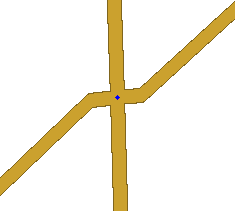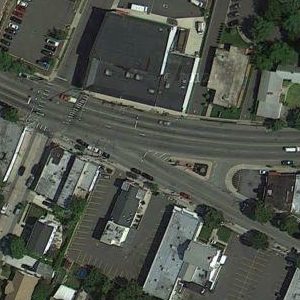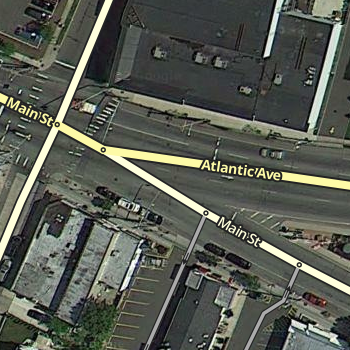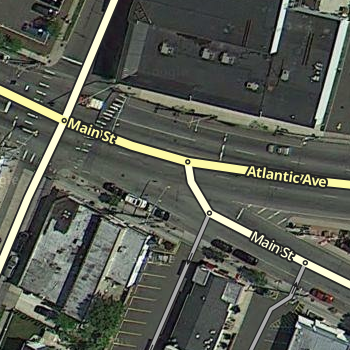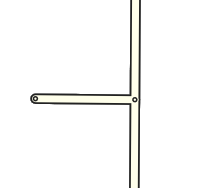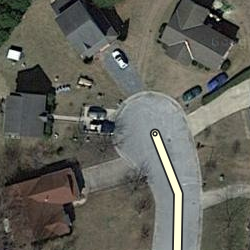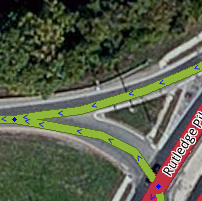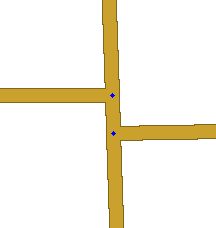(Speeling) |
m (→Oddities) |
||
| Line 330: | Line 330: | ||
The two surface street segments (between the outer ramps and connected to the Single Point) and the 4 ramp segments connected to the single point should all be the same level, either one higher or one lower than the level of the freeway segments above/below the single point. | The two surface street segments (between the outer ramps and connected to the Single Point) and the 4 ramp segments connected to the single point should all be the same level, either one higher or one lower than the level of the freeway segments above/below the single point. | ||
== | == Special Cases == | ||
=== Transitions === | === Transitions === | ||
A transition is a non-junction depicted using a junction node. | A transition is a non-junction depicted using a junction node. | ||
| Line 345: | Line 345: | ||
As long as we are '''certain''' it is not a valid Transition node, a superfluous junction node may be [[Map_Editing_Quick-start_Guide#Delete_a_Junction|deleted]]. Doing so will simplify the map, eliminate turn restrictions to maintain, and ease computing resources needed to calculate routes in the area. Also consider removing the [[Creating_and_Editing_street_segments#Adjusting_road_geometry_.28nodes.29|geometry node]] which will replace the junction node you delete if that geometry node is not needed. | As long as we are '''certain''' it is not a valid Transition node, a superfluous junction node may be [[Map_Editing_Quick-start_Guide#Delete_a_Junction|deleted]]. Doing so will simplify the map, eliminate turn restrictions to maintain, and ease computing resources needed to calculate routes in the area. Also consider removing the [[Creating_and_Editing_street_segments#Adjusting_road_geometry_.28nodes.29|geometry node]] which will replace the junction node you delete if that geometry node is not needed. | ||
=== Roads to Nowhere === | |||
''(coming soon)'' | |||
==== Actual ==== | |||
''(coming soon)'' | |||
==== Fake ==== | |||
''(coming soon)'' | |||
=== Offset Roads === | === Offset Roads === | ||
Revision as of 03:23, 14 August 2012
Simple is better
When representing junctions (a.k.a. intersections, cross roads, corners, etc.) between roads, we sometimes have to blur the lines between the physical and logical worlds. The primary goal should be to represent things as simply as possible and only introduce complexity to deal with an issue.
The Basics ← START HERE
A junction is made up of three things:
- At least two roads
- One or more places these roads meet (a junction node)
- Turns allowed or restricted at those junction nodes
If you do not know how to create and modify roads, junctions, or turns, please read the Map Editing Quick-start Guide.
Lets start with the very basic case of one road branching off from another. Most of the time they will probably meet at close to a 90 degree angle. This is the simplest situation to deal with since the physical and logical views of the roads match up very well.
But you will probably find roads that meet at odd angles as well. Even in urban areas with rigid grids, you will often find at least one road that has existed since prior to the establishment of the grid which cuts through town at strange angles. The initial urge will be to represent the junction as it is in the physical world - two lines running into each other at some angle.
But there are issues with this method. Depending on the angles, the client may give a "Keep Right" instruction to the driver when a "Turn Right" instruction is more appropriate. In some cases, it is even possible the angle may be such that no instruction is given at all. Or worse yet, the routing engine may determine that it isn't possible to make a very sharp angle and not suggest a turn (in the example image, headed south and then turning left to head east).
To eliminate ambiguity, we need to treat the junction from a logical point of view. Since we want to be given basic "Turn Left" and "Turn Right" instructions, we have to treat it like it was a basic 90 degree intersection. But how do we do that when the roads don't actually diverge at 90 degrees? What we need to do is to add some geometry nodes to make the branch road leave the main road at close to 90 degrees, then we gradually curve to match the true departure angle.
Now we have a junction that logically works like a basic 90 degree junction but it also fits the reality of the physical world. Here is a completed real world example:
A ramp to a highway is another good example where additional geometry nodes are helpful. Especially since most ramps diverge at a very small angle from the road.
The drawback in this case (which also exists for the side road example above!) is that it may be very hard to see and click on the turn restriction arrows in the editor.
But if we just add one more geometry node to make the departure angle at the junction itself closer to 20 or 30 degrees...
...now the arrows are visible and accessible. Note that you can also press 's' in the editor to spread or separate the arrows at a junction if you still have difficulty clicking on an arrow. (see Editor Keyboard Shortcuts for more tips.)
We can easily scale the above approaches to a four-way junction. Again we can expect to mostly see angles close to 90 degrees.
And if we have that odd street cutting across town at an odd angle, we again want to avoid the odd angle at the junction...
...and we want to use geometry nodes to bring the actual junction to 90 degrees. You can zoom in as close as you can and add a single geometry node on each side. This will give us the proper angle but make it virtually invisible to users so it looks just like the physical world.
The above image is what you would see zoomed in as close as possible. Zoomed back out, it looks just like the image showing the junction without any geometry nodes.
And here is a real world example at a zoom level where you can still see the geometry adjustment we added:
Controlling Turn Instructions
Before going further, make sure you understand the mechanics of turn restrictions in the Map Editor. If turns are not properly enabled and restricted, you will never get the instructions you desire.
In the Basics section above, we touched on how to ensure a "Turn left/right" instruction would be given over a "Keep left/right" instruction.
Details of the mechanics behind this can be found on the How Waze determines turn / keep / exit maneuvers page, but a summary is provided in the sections below.
Geometry
Some of the complexity of the back-end algorithms can be avoided if we try to treat junctions with the logical view in mind as was done in the previous examples. If all junctions you edit follow just a few basic forms, it will be much easier to predict the behavior of an individual junction.
- Approximately 90 degree departure angle = Turn
- Between 20 and 30 degree departure angle = Keep (or Exit for Ramps)
These angles allow us to clearly depict the desired result (turn vs. keep) while staying within safe margins of the angles the actual algorithms use for decision making. For example, since 45 degrees is a trigger point for the algorithms, a 44.5 degree angle will behave very differently than a 45.5 degree angle.
Similarly, if we have a road split at a Y and we want to be clear about which is "straight" and which bears off to the side, having one branch at zero degrees and the other branch at 5 degrees isn't as clear and obvious as if it were zero degrees vs. 20 degrees. Since most of us will not have a protractor handy every time we are editing, it is best to simply avoid situations where exactness would matter.
This knowledge allows us to control how a junction behaves by modifying a single geometry node in most cases. This is often useful for At-Grade Connectors where sometimes we prefer a "Keep right/left" and other times a "Turn right/left" would be more appropriate.
If we keep the departure angle in the 20 to 30 degree range, we would get a "Keep Right" to follow the curved one-way connector:
But if we move one geometry node to create a 90 degree angle, now we would receive a "Turn Right" instruction.
Similar rules apply for the end of that segment as well. If we have a 20 to 30 degree angle as pictured above, there will be no turn instruction as traffic just smoothly slides into the cross street. But if we make the end of the segment close to a 90 degree angle, then there would be a turn right instruction for the driver.
Segment Naming and Type
Besides the geometry of the road segments, the names and types of the segments come into play.
A basic rule of thumb is that if you want a turn to be announced, having a different name will improve the chances (but not guarantee!!!) that it will happen. For the At-Grade Connector example above, the connector should have a different name than the road it is leaving (See the How to name the connector section of the At-Grade Connectors page).
Highway/Freeway Junctions
These are junctions involving the three Highway/Freeway road types - Minor Highway, Major Highway, and Freeway -- as well as their Ramps.
Highway/Freeway Exits
It is considered to be a basic Exit situation when a "straight" direction is obvious to a driver and navigation instructions are only needed for the non-straight direction (the exit). If navigation instructions are required for both directions, see the Highway/Freeway Splits section below.
To be treated as a basic Exit, the following must be true:
- The entering segment and one exiting segment must be one of the three Highway/Freeway types
- The Highway/Freeway exiting segment must have close to a zero degree departure angle from the entering segment
- The second exiting segment must be of type Ramp
- The Ramp exiting segment must had a departure angle of between 20 and 30 degrees from the entering segment
With those conditions met, the junction will present an "Exit Right/Left" navigation instruction when the ramp is used and will remain silent with no navigation instructions at all when using the Highway/Freeway exiting segment.
Highway/Freeway Splits
We will consider it to be a Highway/Freeway Split when we have a Highway/Freeway segment meeting at a junction with two other Highway/Freeway segments and there is no obvious straight through direction to a driver. To receive a navigation instruction for both branches of a split, the following must be true:
- All segments must be one of the 3 Highway/Freeway Types
- All segments must have names which are different from each other
- The two exiting segments must have departure angles of 20 to 30 degrees from the entering segment
- The segment can be short, but it should be large enough that it is not hard to find in the editor (too subjective, we probably need a minimum length guideline)
With those conditions met, the junction will present "Keep Left" and "Keep Right" navigation instructions using the name of the appropriate exiting segment.
Ramp to Ramp Splits
A ramp may itself split and branch into two directions. If this is the case, "Exit Right" and "Exit Left" will be announced using the name of the appropriate exiting segment in all cases.
Surface Street Junctions
Y Intersections
Surface streets occasionally meet in a Y formation and we must carefully consider how they must be arranged to provide useful navigation instructions. As the How Waze Determines turn/keep/exit maneuvers page explains, segment names and geometry is very important in determining what navigation instructions are (or are not) given.
In the example below, the multi-lane surface street is known as Main Street to the west and Atlantic Ave to the east. The name change occurs when Main St branches off as a regular surface street.
The description above is how a human would probably describe the situation, but as you can see in the image above, a more technical description would be that Main St travels in a perfectly straight line and Atlantic Ave branches off of it. But if we map it that way in the editor, we create a major problem.
Since the multi-lane segment of Main St and the regular street segment of Main St have the same name, the routing engine automatically considers that to be "straight". If the two sections line up in a straight line the way they appear from the sky, then we are reinforcing the idea that straight is Main St to Main St.
But as a driver on the road, straight will be the path that remains on the multi-lane roadway, regardless of what the name is. So to make sure the routing engine "understands" the proper treatment of the junction, we have to be deliberate with the segment geometry of all three involved segments. In the end, we end up with something like this:
Now the geometric definition of straight is multi-lane Main St to Atlantic Ave since we have made that transition as close to zero degrees as possible. With the regular street version of Main St now branching off at a very obvious angle, the routing engine should recognize that a turn is required. So the end result is that Main St to Atlantic has no turn announced and Main St to Main St has a turn announced. Exactly what drivers would expect in the real world.
No Outlet Roads
Roads which only have one way in and one way out can present challenges to the routing server although they seem simple to the human mind.
Dead Ends
Dead Ends (a.k.a. No Exit, Close, No Through Road, No Outlet) are road segments that simply end with no continuation or connections at one end. In some areas, a Dead End may be synonymous with a Cul-de-sac. In the US, a "No Outlet" sign may be used to indicate a road which itself is not a dead end, but it only connects to other dead end roads. It can also be used as a "friendlier" alternative to the typical Dead End sign.
Within the Map Editor it is possible to represent a dead end road with multiple segments if there are private driveways or parking lot roads mapped and connected. In that case, only the very last segment is considered the dead end segment.
Make sure that there is a junction node (not just a geometry node) at the very end of the segment. This is necessary to ensure proper routing out of the segment.
Cul-de-sacs
See also: Cul-de-sac article on Wikipedia
A Cul-de-sac (a.k.a. Court in the US) is a common treatment of a dead end street in a residential neighborhood.
In almost every situation, a cul-de-sac should be treated exactly as a dead end street, with the final junction node in the bulb of the cul-de-sac.
If the cul-de-sac has a very large bulb with an island in the middle, it may better be treated as a Loop if the size truly significant. A basic dead end should be our initial design though, and a Loop only used if problems with "Missing Road" errors occur. For example, this cul-de-sac is perfectly fine treated as a basic dead end:
Loops
Loops are roads that you can enter and without turing around, end up at the same place you started.
The important Map Editor rule we must follow is: a road segment must not start and end on the same junction node.
If this rule is not followed, the routing server will have difficulty in providing routes into and out of the loop.
Hopefully there will be another roadway along the loop road which you can map, which will break the loop into two pieces and avoid the problem. But if there are no interruptions to the loop and the entire loop is represented by one road segment that doubles back on itself, we have a problem
To properly handle this situation, we must insert a superfluous junction node along the loop segment. The specific location does not matter, but most people put it near the half-way point of the segment and/or opposite of the true junction node.
NOTE: It is very easy for you or another editor to find the superfluous junction node, assume it is truly superfluous, and delete it! This problem is magnified if the loop road is large or shaped in a way where it is not obvious that it is a loop. So if you can identify a road to map along the loop, even if it is a parking lot, that would provide a more "permanent" treatment of the loop since the superfluous junction node now serves an obvious purpose.
Roundabouts and Traffic Circles
Please see the Roundabout page for a full discussion of this special type of junction.
At-Grade Connectors
Make sure you don't confuse these segments for ramps! And watch out for turns you need to restrict. For a full discussion, see the At-Grade Connectors page.
Ramps
Ramps have a very specific purpose in Waze. They are intended to connect segments of Minor Highways, Major Highways, and Freeways to roads where there are no at-grade crossings.
When to use ramps
The following conditions must be met for the use of ramps to be appropriate:
- Two roads cross over/under each other with no at-grade junction
- At least one of the roads are of these types
- Minor Highway
- Major Highway
- Freeway
- Ramp
If the above requirements are not satisfied, you may be dealing with an At-Grade Connector.
How complex should ramps be?
Rule #1 is still simpler is better. So unless there is a large deviation of distance between paths at the end of a ramp (either into or out of the ramp as appropriate), a single segment connecting to a single junction node is all that is needed. The simple existence of a painted, concrete, or grass island is NOT enough of a reason to split a ramp into multiple ramps.
Once paths at the end of the ramp deviate significantly in distance, regardless of the existence of any type of island, then it is time to consider multiple ramps.
Limited Access Interchanges
See also: Wikipedia article on Road Interchanges
When two roads meet in a limited access interchange (any situation where travel between grade separated roads is facilitated by ramps or slip roads alone), extra care must be taken.
If an exit ramp lines up with an entrance ramp, care must be taken to restrict the straight through direction to prevent "ramp-to-ramp routing" where the routing engine may try to take a shortcut from the Freeway, to the exit ramp, to the entrance ramp, and back to the Freeway instead of staying on the Freeway. That motion is inefficient and may be illegal in certain jurisdictions.
Care must be taken to not enable all turns in any situation where ramps meet unless all possible flows of traffic have been considered!
We also have to pay attention to the Level of the road segments since there will typically be many bridges and overpasses for any limited access interchange. If two roads cross without connecting, their levels must be different.
The following sections discuss some of the common Interchange designs. Note that some Interchanges may be a hybrid of these basic designs where one side or quadrant of the interchange may differ from the others.
Diamond Interchange
See also: Diamond Interchange article on Wikipedia
Common in wide open spaces where land acquisition and geography are not concerns, this Interchange design has ramps equally distributed across all 4 quadrants.
In the simplest form, this can be represented as single connections from the ramps to the surface street.
Note: Be sure to restrict the straight through motion from the exit ramp onto the entrance ramp on the other side of the road. This will prevent the routing server from trying to route someone off the freeway just to get back on it. Even though it may be a legal direction for a vehicle, turn restrictions are only for controlling routing directions.
If the ramps connect to the surface street at multiple points (be sure to read How complex should ramps be?, we have to avoid ramp-to-ramp routing as well as illegal turns which should use another ramp. First we see the turns that must be restricted for the exit ramps:
Then we see what must be restricted for the entrance ramps:
Note on Levels: The single surface street segment between the inner most ramps should be either raised or lowered in relation to the freeway segments depending on the actual geography at the interchange.
Cloverleaf Interchange
See also: Cloverleaf Interchange article on Wikipedia
In a Cloverleaf Interchange, left turns are eliminated from all movements between the Freeway and the surface street. First check the exit ramps.
Then check the entrance ramps for illegal turns.
The connections to the Freeway segments may be treated in two ways:
- (top) we can have the inner entrance and exit ramps have their own junction nodes with the Freeway.
- (bottom) we can have the entrance and exit ramps share a single junction node with the Freeway. This allows us to eliminate the very short Freeway segment that may exist between the inner entrance and exit ramps.
It is best to offset this shared junction onto the Entrance ramp side of the surface street. This prevents the junction from accidentally being connected to the surface street or looking like it does. We favor the Entrance ramp side, because this would result in a slightly earlier exit instruction which is of course preferred over a late exit instruction.
The determining factor of which design to use will partly depend on the actual size and scale of the specific interchange.
Note on Levels: The single surface street segment between the inner most ramps should be either raised or lowered in relation to the freeway segments depending on the actual geography at the interchange.
Folded Diamond
See also: Discussion of Folded Diamonds and A2/B2 Partial Cloverleafs on the Partial Cloverleaf Interchange article on Wikipedia
Geography or property ownership may prevent the ability for an interchange to be constructed with all ramps evenly distributed across the 4 quadrants of the interchange. When only two quadrants are used, it is typically called a Folded Diamond (basically a sub-type of a Partial Cloverleaf Interchange). The ramps may be all on one side (as in the examples in this section) or they may be located in diagonally opposed quadrants.
The unique situation presented by the Folded Diamond arrangement is having both Entrance and Exit ramps terminating on the same side of the surface street. Ideally both ramps should terminate on the same junction node to permit us to easily restrict the illegal and usually impossible ramp-to-ramp movement.
Like with a basic Diamond Interchange, often it will be necessary to represent the ramps making multiple connections to the surface street (Be sure to read How complex should ramps be?. Restrict all non-permitted turns.
Note on Levels: Similar to a basic Diamond interchange, in most cases only the segment of the surface street that crosses the Freeway segments will need to be adjusted up or down.
Single Point Urban Interchange (SPUI)
See also: Single Point Urban Interchange article on Wikipedia
A SPUI is a very space and flow efficient design, but it takes extra attention to ensure the turns are correct. And as the name indicates, ideally there should be a single junction in the center. You may need to tweak the geometry of segments a bit off of alignment from the real physical world, but it should be minor if the interchange is a true SPUI.
The outer branches of the exit ramps are very much like in the case of a diamond interchange:
Where things get complicated is the inner branches leading to the Single Point. You need to avoid ramp-to-ramp in two directions and a reverse flow turn. Note: The ramp-to-ramp motion to facilitate a U-Turn (the top left arrow in the image below) may or may not be allowed depending on the specific interchange. Please validate this turn.
Luckily the entrance ramp restrictions are similar to the diamond interchange:
If you were to look at all the restricted turns at once, you may get the false impression that something is very wrong. But as you now know, a SPUI has almost as many restricted turns as allowed ones.
Note on Levels: The two surface street segments (between the outer ramps and connected to the Single Point) and the 4 ramp segments connected to the single point should all be the same level, either one higher or one lower than the level of the freeway segments above/below the single point.
Special Cases
Transitions
A transition is a non-junction depicted using a junction node.
Valid examples of where to use a Transition node include:
- Road name changes
- City Limits
- Road Direction changes
- Part of a Loop Road
There may be exiting Transition nodes on the map for other reasons (left over after a connecting road was deleted, due to the original base map import when things such as rivers and streams created junctions, etc.).
As long as we are certain it is not a valid Transition node, a superfluous junction node may be deleted. Doing so will simplify the map, eliminate turn restrictions to maintain, and ease computing resources needed to calculate routes in the area. Also consider removing the geometry node which will replace the junction node you delete if that geometry node is not needed.
Roads to Nowhere
(coming soon)
Actual
(coming soon)
Fake
(coming soon)
Offset Roads
Sometimes you will find two roads which cross where one does not quite line up exactly from one side to the other.
There are a few things we need to look at in this situation.
- Do the roads actually line up in reality? If so we need to modify the junction to be a basic 4-way junction.
- Do the roads ALMOST line up in reality? If you were giving instructions to a person and would tell them to go straight with no mention of any slight turn or jog, then we want to make it into a 4-way junction. You may need to "split the difference" and not follow the centerline of either road to achieve this. The angles are exaggerated in this next example to show how the junction is forced to be close to 90 degrees, then we taper to the true centerlines of the roads. In practice this can be much more gradual and/or only done while zoomed in very close.


- Finally, is there a true separation between the roads? Would you need to say for example "turn left then make an immediate right"? If so then we will want to leave the junction such that the two sides do not align.

Since we want to avoid very short segments of road (the GPS chips in consumer devices can be very inaccurate which may make it seem that a driver skipped right over a short segment which will result in automated map errors and possible route recalculations in the client), it may be wise to shift the side roads as far apart from each other as possible with them still in the proper location (along the far curb lines for a residential street for example). This will maximize the length of the short segment between the side roads.











